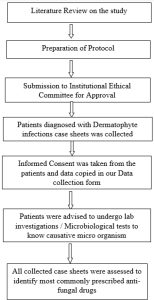
ABSTRACT
Background: The most prevalent fungus infections that adversely affect people of all ages are called dermatophytoses. It is brought on by a particular class of fungus called ringworms, sometimes known as tineas, which includes the species Microsporum, Trichophyton, and Epidermophyton. About 20–25% of people worldwide have dermatophytosis. Direct contact with sick people can spread the disease, as can indirect contact with contaminated fomites. To determine the epidemiology, risk factors, clinical trends, and treatment profile of Superficial Fungal Infections, the current investigation was conducted (SFIs). Materials and Methods: A hospital-based prospective observational cross-sectional study was carried out at RIMS, Kadapa for six months, from November 2021 to April 2022. Based on the inclusion criteria, 120 patients were chosen. Data was gathered, examined, and summarized as averages. Microsoft Excel was used to represent the data using the graph pad prism programme. Results: In a total of 120 patients with tinea infections, we discovered that 45 were men and 75 were women; 64 patients are in the middle age group; 51 had BMI values below 18.5; 73 are illiterate; 15 have social habits; 60 are housewives; and 93 got Tinea as a result of towel sharing. In 87 patients with Tinea corporis, the upper and lower limbs were frequently afflicted; Trichophyton rubrum was isolated in 97 cases. There were 527 prescriptions total, of which 315 were for oral treatments and 212 were for topical treatments. Conclusion: Tinea corporis was the most common superficial fungal infection found in the GGH-RIMS. The most frequent species of Trichophyton isolated from patients with tinea was Trichophyton rubrum. Both the antifungal drug miconazole and the antihistamine drug CPM were widely prescribed.
